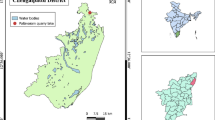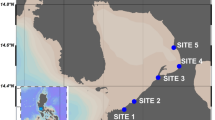Abstract
We investigated changes in sediment bacterial community structure across a spatial organic enrichment gradient associated with fish farms in two different sites in the Eastern Mediterranean (Greece). The observed trend was similar at both fish farms even though they are far from each other. The mean number of the most abundant operational taxonomic units (OTUs) was not significantly different, either among samples across the organic enrichment gradient or between impacted and control samples at both fish farms. Nevertheless, community structure differed both within each site (impacted vs. control samples) and between the two sites. We found that most of between-site differences in community structure could be attributed to differences in grain size, redox potential of the sediment, and, to a lesser extent, chlorophyll α, while within-site differences were attributed to the distance from the cage and the median grain size. Sequenced DGGE bands that were present only at samples directly beneath the cages, affiliated with different phylogenetic groups at each site. These results indicate that aquaculture effluents affect the structure of sediment bacterial communities, but without any apparent impact on the number of the most abundant OTUs.




Similar content being viewed by others
References
Apostolaki ET, Holmer M, Marbà N, Karakassis I (2010) Degrading seagrass (Posidonia oceanica) ecosystems: a source of dissolved matter in the Mediterranean. Hydrobiologia 649(1):13–23
Asami H, Aida M, Watanabe K (2005) Accelerated sulfur cycle in coastal marine sediment beneath areas of intensive shellfish aquaculture. Appl Environ Microbiol 71(6):2925–2933
Bissett A, Bowman J, Burke C (2006) Bacterial diversity in organically-enriched fish farm sediments. FEMS Microbiol Ecol 55(1):48–56
Bissett A, Burke C, Cook PLM, Bowman JP (2007) Bacterial community shifts in organically perturbed sediments. Environ Microbiol 9(1):46–60
Brown JR, Gowen RJ, McLusky DS (1987) The effect of salmon farming on the benthos of a Scottish sea loch. J Exp Mar Biol Ecol 109(1):39–51
Campbell BJ, Engel AS, Porter ML, Takai K (2006) The versatile ε-proteobacteria: key players in sulphidic habitats. Nat Rev Microbiol 4(6):458–468
Clarke KR (1993) Non-parametric multivariate analyses of changes in community structure. Aust J Ecol 18(1):117–143
Clarke KR, Warwick RM (1998) A taxonomic distinctness index and its statistical properties. J Appl Ecol 35(4):523–531
Deming JW, Baross JA (1993) Deep-sea smokers: windows to a subsurface biosphere? Geochim Cosmochim Acta 57(14):3219–3230
Engel AS, Lee N, Porter ML, Stern LA, Bennett PC, Wagner M (2003) Filamentous “Epsilonproteobacteria” dominate microbial mats from sulfidic cave springs. Appl Environ Microbiol 69(9):5503–5511
Engel AS, Porter ML, Stern LA, Quinlan S, Bennett PC (2004) Bacterial diversity and ecosystem function of filamentous microbial mats from aphotic (cave) sulfidic springs dominated by chemolithoautotrophic “Epsilonproteobacteria”. FEMS Microbiol Ecol 51(1):31–53
Findlay RH, Watling L, Mayer LM (1995) Environmental impact of salmon net-pen culture on marine benthic communities in Maine: a case study. Estuaries 18(1):145–179
Gooday AJ (2002) Biological responses to seasonally varying fluxes of organic matter to the ocean floor: a review. J Oceanogr 58(2):305–332
Hargrave BT, Duplisea DE, Pfeiffer E, Wildish DJ (1993) Seasonal changes in benthic fluxes of dissolved oxygen and ammonium associated with marine cultured Atlantic salmon. Mar Ecol Prog Ser 96(3):249–257
Holmer M, Argyrou M, Dalsgaard T, Danovaro R, Diaz-Almela E, Duarte CM, Frederiksen M, Grau A, Karakassis I, Marbà N, Mirto S, Pérez M, Pusceddu A, Tsapakis M (2008) Effects of fish farm waste on Posidonia oceanica meadows: synthesis and provision of monitoring and management tools. Mar Pollut Bull 56(9):1618–1629
Karakassis I, Tsapakis M, Hatziyanni E (1998) Seasonal variability in sediment profiles beneath fish farm cages in the Mediterranean. Mar Ecol Prog Ser 162:243–252
Karakassis I, Hatziyanni E, Tsapakis M, Plaiti W (1999) Benthic recovery following cessation of fish farming: a series of successes and catastrophes. Mar Ecol Prog Ser 184:205–218
Karakassis I, Tsapakis M, Hatziyanni E, Papadopoulou KN, Plaiti W (2000) Impact of cage farming of fish on the seabed in three Mediterranean coastal areas. ICES J Mar Sci 57(5):1462–1471
Kawahara N, Shigematsu K, Miyadai T, Kondo R (2009) Comparison of bacterial communities in fish farm sediments along an organic enrichment gradient. Aquaculture 287(1–2):107–113
Kondo R, Mori Y, Sakami T (2012) Comparison of sulphate-reducing bacterial communities in Japanese fish farm sediments with different levels of organic enrichment. Microbes Environ 27(2):193–199. doi:10.1264/jsme2.ME11278
Lampadariou N, Karakassis I, Pearson TH (2005) Cost/benefit analysis of a benthic monitoring programme of organic benthic enrichment using different sampling and analysis methods. Mar Pollut Bull 50(12):1606–1618
Li J, Li F, Yu S, Qin S, Wang G (2013) Impacts of mariculture on the diversity of bacterial communities within intertidal sediments in the Northeast of China. Microb Ecol 66(4):861–870. doi:10.1007/s00248-013-0272-6
Marcial Gomes NC, Borges LR, Paranhos R, Pinto FN, Mendonça-Hagler LCS, Smalla K (2008) Exploring the diversity of bacterial communities in sediments of urban mangrove forests. FEMS Microbiol Ecol 66(1):96–109
McCaig AE, Phillips CJ, Stephen JR, Kowalchuk GA, Martyn Harvey S, Herbert RA, Martin Embley T, Prosser JI (1999) Nitrogen cycling and community structure of proteobacterial β-subgroup ammonia-oxidizing bacteria within polluted marine fish farm sediments. Appl Environ Microbiol 65(1):213–220
Muyzer G, Smalla K (1998) Application of denaturing gradient gel electrophoresis (DGGE) and temperature gradient gel electrophoresis (TGGE) in microbial ecology. Anton Leeuw Int J Gen Mol Microbiol 73(1):127–141
Muyzer G, De Waal EC, Uitterlinden AG (1993) Profiling of complex microbial populations by denaturing gradient gel electrophoresis analysis of polymerase chain reaction-amplified genes coding for 16S rRNA. Appl Environ Microbiol 59(3):695–700
Papageorgiou N, Kalantzi I, Karakassis I (2010) Effects of fish farming on the biological and geochemical properties of muddy and sandy sediments in the Mediterranean Sea. Mar Environ Res 69(5):326–336
Polz MF, Cavanaugh CM (1995) Dominance of one bacterial phylotype at a Mid-Atlantic Ridge hydrothermal vent site. Proc Natl Acad Sci 92(16):7232–7236
Powell SM, Bowman JP, Snape I, Stark JS (2003) Microbial community variation in pristine and polluted nearshore Antarctic sediments. FEMS Microbiol Ecol 45(2):135–145
Sánchez O, Gasol JM, Massana R, Mas J, Pedrós-Alió C (2007) Comparison of different denaturing gradient gel electrophoresis primer sets for the study of marine bacterioplankton communities. Appl Environ Microbiol 73(18):5962–5967
Sebastian M, Pitta P, Gonzalez JM, Thingstad TF, Gasol JM (2012) Bacterioplankton groups involved in the uptake of phosphate and dissolved organic phosphorus in a mesocosm experiment with P-starved Mediterranean waters. Environ Microbiol 14(9):2334–2347. doi:10.1111/j.1462-2920.2012.02772.x
Tamminen M, Karkman A, Corander J, Paulin L, Virta M (2011) Differences in bacterial community composition in Baltic Sea sediment in response to fish farming. Aquaculture 313(1–4):15–23. doi:10.1016/j.aquaculture.2011.01.020
Teira E, Martínez-García S, Carreira C, Morán XAG (2011) Changes in bacterioplankton and phytoplankton community composition in response to nutrient additions in coastal waters off the NW Iberian Peninsula. Mar Ecol Prog Ser 426:87–104. doi:10.3354/meps09008
Thingstad TF, Krom MD, Mantoura RF, Flaten GA, Groom S, Herut B, Kress N, Law CS, Pasternak A, Pitta P, Psarra S, Rassoulzadegan F, Tanaka T, Tselepides A, Wassmann P, Woodward EM, Riser CW, Zodiatis G, Zohary T (2005) Nature of phosphorus limitation in the ultraoligotrophic eastern Mediterranean. Science 309(5737):1068–1071. doi:10.1126/science.1112632
Torsvik V, Sørheim R, Goksøyr J (1996) Total bacterial diversity in soil and sediment communities—A review. J Ind Microbiol Biotechnol 17(3–4):170–178
Vezzulli L, Chelossi E, Riccardi G, Fabiano M (2002) Bacterial community structure and activity in fish farm sediments of the Ligurian Sea (Western Mediterranean). Aquac Int 10(2):123–141
Webster G, John Parkes R, Cragg BA, Newberry CJ, Weightman AJ, Fry JC (2006) Prokaryotic community composition and biogeochemical processes in deep subseafloor sediments from the Peru Margin. FEMS Microbiol Ecol 58(1):65–85
Weisburg WG, Barns SM, Pelletier DA, Lane DJ (1991) 16S ribosomal DNA amplification for phylogenetic study. J Bacteriol 173(2):697–703
Wildish DJ, Hargrave BT, Pohle G (2001) Cost-effective monitoring of organic enrichment resulting from salmon mariculture. ICES J Mar Sci 58(2):469–476
Zhang W, Ki JS, Qian PY (2008) Microbial diversity in polluted harbor sediments I: bacterial community assessment based on four clone libraries of 16S rDNA. Estuar Coast Shelf Sci 76(3):668–681
Author information
Authors and Affiliations
Corresponding author
Electronic supplementary material
Below is the link to the electronic supplementary material.
Online Resource 1
(PDF 370 kb)
Online Resource 2
(PDF 377 kb)
Rights and permissions
About this article
Cite this article
Fodelianakis, S., Papageorgiou, N., Karakassis, I. et al. Community structure changes in sediment bacterial communities along an organic enrichment gradient associated with fish farming. Ann Microbiol 65, 331–338 (2015). https://doi.org/10.1007/s13213-014-0865-4
Received:
Accepted:
Published:
Issue Date:
DOI: https://doi.org/10.1007/s13213-014-0865-4




